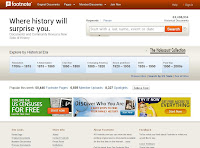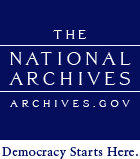 Here is an update from Roger Joslyn a Fellow of the American Society of Genealogists, regarding the recent news about the National Archives – Northeast Region, Manhattan Branch. You’ll recall that I ran Joslyn’s first letter of concern that the NYC National Archives was under threat on February 17th. I ran more news of the Archives move on March 15th. Here is the latest from Joslyn:
Here is an update from Roger Joslyn a Fellow of the American Society of Genealogists, regarding the recent news about the National Archives – Northeast Region, Manhattan Branch. You’ll recall that I ran Joslyn’s first letter of concern that the NYC National Archives was under threat on February 17th. I ran more news of the Archives move on March 15th. Here is the latest from Joslyn:
Hello, again
Thank you for the many responses to my letter concerning the possibility of losing our National Archives–Northeast Region as an important research facility. The response was overwhelming and I regret I could not answer all the many e-mails. I understand my letter was circulated pretty far and wide and some persons wrote me from other countries. Many of you conveyed good thoughts about the issue, telling of similar experiences, and several wrote to offer, “What can I do?”
My apologies if I missed sending first my letter to a few people who are receiving this one, and if so, please let me know and I shall send the earlier one if you want to see it.
The main purpose of my first letter was to let you know what I knew and had heard about the planned move of NARA’s New York regional facility. At the time of my first letter, NARA had put nothing out to the pubic about the intended move, about any reduction in space and on-site research materials, and so forth. As I then wrote, some of the plans were told to Stuart Stahl by NARA’s Diane LeBlanc for him to pass the word. So, “officially,” that is the best information there was at the time, but one might also still consider any of those details to be “rumor” at that point.
Since the first letter, NARA has responded, and I have been told or led to believe that a positive result of my letter was that it put things in action sooner than later. I have had telephone conversations with Diane LeBlanc and other NARA personnel about the move of the New York regional facility and I refer you (below) to NARA’s official word about the move and also to some NARA-prepared FAQs. As you will see, some of information is different and/or a little more detailed than what had been said and circulated earlier.
http://www.archives.gov/northeast/nyc/move-notice.html
http://www.archives.gov/northeast/nyc/move-faq.html
Also since sending my first letter, I have been able to visit what will be NARA-NYC’s new home in the Customs House in lower Manhattan. There is no question the building is a lovely place and, when the space is renovated, will provide pleasing accommodations for researchers, staff, and programs. NARA’s Public Programs Specialists Dorothy Doughty is quite excited about the possibilities for the latter, not only for large and small presentations and workshops, but also because there is room for (for example) genealogical/historical fairs and so forth, using space NARA will share with other agencies in the building. (And without a lockup in the building as there is at 201 Varick Street, the security staff in the Customs House is more welcoming to visitors.)
While there is no question the new location will be a nicer home for NARA-NYC for the above reasons, the amount of storage space for textual records and microfilm will be greatly reduced.
I would like to add from my conversations with Diane LeBlanc some additional points that are of interest and/or concern to us as researchers.
Ms. LeBlanc said that NARA-NYC is “going through a process” in preparation for the move, which will likely take place eighteen to twenty-four months from now. She sees the Customs House as having “enormous potential” for NARA. One example is that being near the Circle Line terminal for Ellis and Liberty Island visits, there is increased possibility to attract tourists to the Customs House and thus to NARA.
According to Ms. LeBlanc, NARA-NYC currently has about 40,000 cubic feet of textual records at Varick Street, but with limited space in the Customs House, only about 5300 cubit feet of records can be housed there. (The 5000 square feet reported earlier as being the total of the new space was a misunderstanding about room for the textual records- NARA will actually have about 20,000 total square feet that includes public and office space, storage room, and so forth.)
Apparently, NARA looked at a number of possible new locations and chose the Customs House as the best of the bunch. The main argument for settling for the much-reduced storage space is that patron usage is down. What cannot fit in the new space will go to a new storage facility in Philadelphia. Ms. LeBlanc says the off-site material will have the “same access” by shuttle to New York City that is now provided for other off-site materials. The frequency of the shuttle service is still under discussion.
Similarly, because of less storage space, NARA will also not be able to take all its current microfilm collection to the Customs House. Ms. LeBlanc says there is room for only about twenty percent of the film. What becomes of the other eighty percent of the microfilm has not been determined, but Ms. LeBlanc said there may be some possibilities for keeping it in New York City, if some other repository can take it. She thought New York Public Library’s microfilm collection nearly duplicated that at NARA-NYC. I told her this is not the case.
In order to determine what textual records and microfilm will likely be moved to the Customs House, NARA staff and volunteers will be “assessing” customer usage—what material, textual and microform, gets the most on-site use. (A large amount of NARA-NYC’s collection, mostly voluminous court records, is already stored off-site in Lee Summit, Missouri.) I reminded Ms. LeBlanc that much of the more-used microfilm is self-serve, that patrons take and replace microfilms themselves. This limits what staff and volunteers may be able to determine about usage. They are more aware of the usage of specific microfilms they must retrieve for patrons from the back “stacks.”
Ms. LeBlanc clarified that certification of copies of records at NARA-NYC will still be possible. Certifications needed from microfilm that will no longer be at NARA-NYC can be requested to be done at NARA-Pittsfield, or the microfilm can be brought in from Pittsfield to be certified at NARA-NYC.
She also said that over time, what textual records are actually kept on-site in the new facility could change, based on patron usage. For example, if there was increased call for ships’ original passenger lists, they might be brought in from off-site storage and less-requested material sent off site.
Two other things need clarification. First, volunteers will continue to be needed and they, in addition to helping patrons, will be involved with projects. There will be designated space for projects in the new facility, with textual records brought in from off-site for such projects as needed.
Second, the expansion at NARA-Waltham mentioned in my first letter is for public programming space. Some of this new space was formerly used to store microfilm, a large amount of which was given to the library in Plano, Texas, because, as Ms. LeBlanc explained, “no one else wanted it.”
I wrote my first letter in reaction to the response a colleague received who suggested to NARA that some of the more frequent patrons might be consulted for input about the upcoming mov
e, records use, and so forth. The person was told that no one was going to tell NARA what to do. NARA staff has told me that, following former Archivist John Carlin’s attempt to move large amounts of material out of the regional facilities, that NARA has became more sensitive to public wants, needs, and so forth. So the response to my colleague was out of line and certainly was not good business. We expect better from an agency that has long been one of our primary repositories for the research we do.
Ms. LeBlanc agreed. In acknowledging that my first letter got NARA’s attention, she stated, “We will do this better than we did in the past.” The move to the Customs House seems set, and while my opinion is that user involvement before that decision would have been helpful and should have been sought, NARA-NYC is holding two public meetings about the move (see the announcement). I hope those of you who are interested in the move and have concerns and questions will attend. It is not clear if whatever is voiced at these meetings will change any of NARA’s plans at this point, but those of us who are concerned should go and speak up.
Here are just two of the many concerns about which some of you have written to me.
“It’s all online.” And many of us doubt it ever will be. But even with all that is available on the Internet, we have all experienced problems that take us back to the original sources, or at least back to the microfilm, for a variety of reasons, including legibility, printing, missed material, even speed. Can we be content with loosing easy access to what we now have so readily available?
Out of sight, out of mind, or never in mind at all. Ms. LeBlanc agreed that this is one area where NARA can use a lot of improvement. Many patrons have no idea what else there is beyond the Federal censuses, passenger lists, and a few other microfilmed records. With less microfilm in the public space for users to actually see some examples of what resources there are, there need to be ways of letting researchers know about the wealth of other records that might help them—microfilm and textual.
If NARA is willing to let its users work with them to do better and not just be informed of what others have decided, is that not a positive thing?
Roger Joslyn
P.S. I realize that most people who learn “what we do” usually react with, “That’s very interesting!” or “My aunt was the family historian,” and so forth. But we also frequently encounter those who cannot fathom such an interest in the past. In these instances, I am always reminded of what is carved on the National Archives building in Washington, D.C., as you all know so well: “The Past is Prologue.”
This was brought home the other night as Leslie and I viewed (from Netflix) Masterpiece Theatre’s Shooting the Past, about a photo archives doomed to the trash and the staff’s struggle to save it. We were deeply moved and saw parallels with what has happened and will likely continue to happen in our field. For those of you who have not seen this wonderful BBC drama, I strongly recommend it. In the meantime, you can read a little bit about it at
http://en.wikipedia.org/wiki/Shooting_the_Past
and in this New York Times review
http://www.nytimes.com/1999/11/21/tv/spotlight-an-imperiled-muse-weaves-her-spell.html?pagewanted=1
 Due to an asbestos abatement project on the second floor of the Central Library, the storage collections of the Schenectady County Public Library will be unavailable from now until approximately the middle of June, according to Bob Sullivan of the Schenectady Digital History Archive.
Due to an asbestos abatement project on the second floor of the Central Library, the storage collections of the Schenectady County Public Library will be unavailable from now until approximately the middle of June, according to Bob Sullivan of the Schenectady Digital History Archive.






